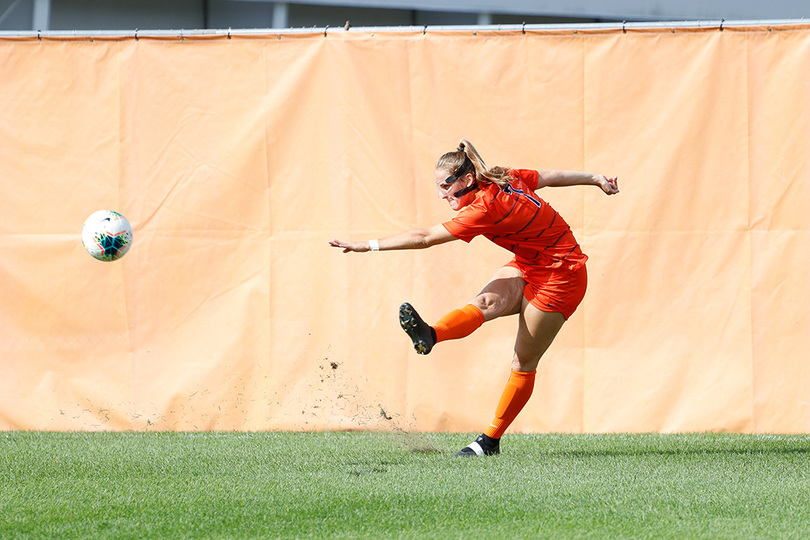Syracuse struggles to perform well after halftime late in season

Senior Taylor Bennett takes a free kick in the match against Florida State. Elizabeth Billman | Asst. Photo Editor
Nicky Adams couldn’t understand her team’s mentality coming out for the second half against Miami. Syracuse had outshot the Hurricanes in the first half, 9-1, and the Orange went into the break tied at one apiece. No signs pointed to a second-half domination from the Hurricanes, but that’s what happened on Oct. 13.
Miami didn’t change anything for the second half, Adams said, but “outworked” SU to the tune of a 16-1 shot advantage. SU’s second half performance was inexplicable, both for Adams and her team, she said.
Nine days and another loss removed from their matchup against Miami, the Orange (3-9-2, 1-5-1 Atlantic Coast) are still searching for answers. Before its most recent two losses, Syracuse had won its first ACC game in nearly a year against Wake Forest, coming back from a goal down to do so. But since, the Orange have struggled to put together a full 90-minute performance and reverted to their earlier-season form when they went winless between Aug. 29 to Oct. 10.
“We’re still trying to figure out why there was a drop when there shouldn’t have been a drop,” defender turned midfielder Shannon Aviza said. “And we know we can play with these teams when we’re at our best.”
Under Adams, who took over in March of this year, the Orange have looked to possess the ball more than in past years under previous head coach Phil Wheddon. They aren’t reliant on sitting back and they’re pressing for large portions of games. SU has already equaled its win total from last year (three), but otherwise have struggled.
The possession has only led to nine goals this season, though. Syracuse has three games, two against top-10 teams, to reach the 11 goals it scored last year.
The issues have started at the back and in transition. Miami’s game-winning goal came after an SU free kick was sent into the box. After clearing the danger, the Hurricanes found a run in behind by Miami’s Kristina Fisher who was one-on-one with Lysianne Proulx. The keeper stopped the initial shot, but it bounced to Miami’s Michelle Giamportone. Her shot came off the top of the bar and bounced back into the six-yard box, where, surrounded by Syracuse defenders, Hurricanes defender Bayleigh Chaviers headed it home.
Players tracked back, but three Miami players had looks on goal because SU players didn’t know who to pick up in transition. The Orange don’t need to work harder, Taylor Bennett said, just smarter and for longer.
Part of SU’s struggles are due to injuriesand inexperience. Without many substitutes, players get tired in the second half and drop back instead of pressing. That gave Miami, Clemson and Wake Forest the chance to break down the SU defense with short passes. When Syracuse pressed Miami in the first half, the Hurricanes keeper played the ball out of bounds multiple times and it didn’t create any sustained attack. After halftime, when SU pressed, it couldn’t match the pace of the Miami counterattack, like on the game-winning goal.
“It’s just a lot of the mental part of it and the heart and not giving up and just piecing together a full game,” Aviza said.

Amy Nakamura | Co-Digital Editor
In its last three games, SU has tried to possess the ball more against weaker opponents. Against Wake Forest, it worked in the second half as Syracuse came back to tie and then eventually win in overtime. With time at the back, Bennett and Jenna Tivnan, two of the best in the conference at playing long balls, Adams said, were able to find the Orange wingers and forwards making runs in behind.
But the two have often become reliant on long balls instead of swinging it around the backline. When the midfielders and forwards did receive the ball, they didn’t look ahead, instead choosing to lay it off back to the defenders. Unlike against Wake Forest, there was no interplay between the attackers to create holes in the Miami defense.
SU also doesn’t have many options for long ball outlets besides Sydney Brackett. Even Brackett isn’t a proper striker and is more of a winger, Adams said, which hurts SU’s ability to sustain possession and build attacks.
At Clemson last weekend, Syracuse had several prime chances, but headed into halftime down 2-0. In the second half, the Orange started dropping back and soaking pressure. SU didn’t generate any chances until Stephanie deLaforcade toe-poked in an 88th minute goal.
“It didn’t matter what we were saying from afar,” Adams said of the 4-1 loss. “They just kept dropping and dropping and trying to protect the goal instead of stepping up and pressure and trying to win it higher, and when you get into that type of funk, it’s very, very hard to get out of.”
Despite it being a development year for a rebuilding program, there have been flashes of potential — Meghan Root’s first-half goal against Miami, SU’s first ACC win in nearly a year and two-straight wins at home to start the season. They just have to work on being more consistent.
“Come out with the same energy we did against Wake Forest and the first half of Miami against every single team,” Bennett said. “Not just hold it for 20 minutes.”
“Hold it for a whole 90.”




